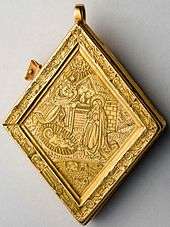Middleham Jewel


The Middleham Jewel is a late 15th-century gold pendant, set with a large blue sapphire stone. Each side of the lozenge-shaped pendant is engraved with a religious scene. It was discovered by a metal detectorist in 1985 near Middleham Castle, the northern home of Richard III, and acquired by the Yorkshire Museum in York for £2.5 million.
The pendant is a 68 grams (2.4 oz) gold pendant with a 10 carats (2.0 g) blue sapphire stone set on one face. It measures approximately 6.4 centimetres (2.5 in) across. The blue jewel was believed to have medicinal qualities, providing protection against illness, and was considered to be a cure for aliments such as ulcers, poor eyesight, headaches and stammers. Blue is also the colour of the Virgin Mary, and the jewel may have been intended to assist childbirth.
The obverse bears a representation of the Trinity, including the Crucifixion of Jesus, bordered by a Latin inscription "Ecce Agnus Dei qui tollis peccata mundi ... miserere nobis ... tetragramaton ... Ananyzapta" – the last possibly a magic word, intended to protect the user from epilepsy.[1] The reverse face bears an engraving of the Nativity, with the Lamb of God, bordered by the faces of fifteen saints, some bearing attributes that allow them to be identified as St Peter, St George, St Barbara, and St Margaret of Antioch, Catherine of Alexandria, Dorothea of Caesarea, and St Anne. Suggestions for the others include St Augustine of Hippo, St Nicholas of Myra, St Jerome, Anthony of Padua, St Agnes, St Cecilia, St Clare of Assisi, and St Helena or Bridget of Sweden.[2] The pendant may originally have been further decorated with enamelling on each face and pearls around the edge.
The back panel slides to reveal a hollow interior, which originally contained three and a half tiny discs of silk embroidered with gold thread.[3] The textile contents identify the jewel as a reliquary, containing a fragment of holy cloth. It would have been worn by a high-status lady, as the centrepiece for a large necklace.[4] The sapphire may represent heaven,[5] and could have acted as aid to prayer.
A high status item, it may have been owned by a relation of Richard III, possibly his wife Anne Neville, or his mother Cecily Neville, or his mother-in-law, Anne Beauchamp (1426–92), widow of Warwick the Kingmaker.
The jewel was found in 1985 on a bridle path near Middleham Castle by Ted Seaton using a metal detector.[4] At a treasure trove inquiry, it was declared lost or abandoned, and sold at Sotheby's in 1986, for £1.4m, but an export licence was temporarily refused to allow matching funds to be raised. It was acquired by the Yorkshire Museum in York in 1992 for £2.5 million, using funds raised by a public appeal, including £1.7m from the National Heritage Memorial Fund, £350,000 from John Paul Getty, Jr, £180,000 from the National Art Collections Fund, £75,000 from the Headley Trust, £60,000 from the Victoria and Albert Museum, £25,000 pounds from the Goldsmith's Company, and £20,000 donated by members of the public. There were also donations from North Yorkshire County Council, the Richard III Society, and the Wolfson Foundation.
An exact replica of the Jewel is now back at Middleham. The original is displayed in the Yorkshire Museum, York.
Notes
- ↑ "Middleham Jewel". Art Fund. 11 June 2013.
- ↑ York
- ↑ Cherry 1994, pp. 24–26.
- 1 2 Cherry 1994, pp. 16–17.
- ↑ Cherry, John. The Holy Thorn Reliquary, p. 7, 2010, British Museum Press (British Museum objects in focus), ISBN 0-7141-2820-1
Sources
- Cherry, John (1994), The Middleham Jewel and Ring, Yorkshire Museum (York)
- "York": Middleham Jewel, University of York
References
- The Middleham Jewel, Art Fund
- A tale of treasure hunters and the secret past of a 500-year-old jewel, Lancashire Telegraph, 1 October 2010
- Middleham Jewel, A History of the World, BBC
- Middleham Jewel, History of York
- Saga of the Middleham Jewel, Vera Seaton, Author House, 2014, ISBN 1496975693